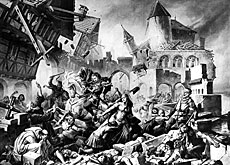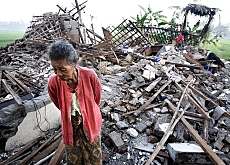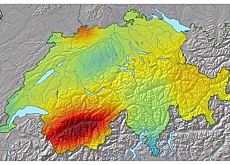Switzerland prepares for seismic calamity

Swiss emergency officials have been participating in a huge cross-border earthquake preparedness exercise to learn how to deal with strong tremors.
The disaster simulation in the Rhine valley area coincides with the 650th anniversary of the great Basel earthquake on October 18, 1356 – an estimated 6.5 magnitude quake which destroyed most of the city.
The Rheintal 06 is a three-day exercise being staged by Switzerland, Austria and Liechtenstein.
Under the fictitious scenario, an imaginary 6.0-magnitude earthquake hit eastern Switzerland at 5am on Tuesday. The three countries had to mobilise disaster teams to assist more than 420,000 people hit by the quake as well as deal with damage to buildings and infrastructure.
The organisers say the exercise allows them to be better prepared for real disasters, especially as earthquakes remain a real threat in Switzerland.
According to the Swiss Seismological Service, there have been more than 10,000 earthquakes in Switzerland over the past 800 years. Half a dozen of them have registered more than 6.0 on the Richter scale and experts predict that a similar-sized quake is certain to occur in the future.
“There is a risk of earthquakes in the Rhine valley, although the higher risks are in Basel and canton Valais,” Sven Bradke, a spokesman for Rheintal 06, told swissinfo. “Our region has earthquakes every year – not on the same scale as that of the exercise – but they could happen.”
Joint venture
Rheintal 06, which took more than three years to prepare, involves over 1,200 people from civil protection teams, emergency services and the armed forces. They come from Liechtenstein, the Austrian Vorarlberg region, and cantons St Gallen and Appenzell Inner Rhodes.
The groups had to deal with a scenario where more than 420,000 people in the three countries were affected by the fictitious quake, with 12 killed, 1,800 injured and 250 people thought to be missing. The authorities also estimated that 170,000 people would be made temporarily homeless.
Numerous buildings and other infrastructure, including roads, bridges, water, electricity and communication networks were damaged by the tremor or were no longer operational, according to the simulation.
The teams will be re-enacting the disaster and will be trying to ensure a proper coordinated response.
“Preparing ahead of the exercise has taught us a great deal about earthquakes and allowed us to optimise procedures,” said Bradke.
“It has also enabled us to develop numerous contacts with people working in the same field in neighbouring countries. And it has helped us to work faster and not to waste too much time – something invaluable in disaster situations.”
Basel quake
The fact that the exercise takes place during the same week as the 650th anniversary of the great Basel earthquake is pure coincidence, explained Bradke.
But he remains convinced that a quake of similar magnitude could hit Switzerland.
According to historical records, a first earthquake struck Basel in the early evening of October 18, 1356, setting the stage for a second, stronger tremor later that night, estimated at 6.5 on the Richter scale.
Between 30 and 40 medieval castles collapsed in the earthquake zone, a fire gutted the city centre and 300 people were thought to have died.
Swiss experts estimate that an earthquake similar to the 1356 event would now cause damage in the region of SFr50-80 billion ($30-50 billion). They say the potential for high financial loss makes earthquakes the most serious natural hazard in Switzerland.
swissinfo, Simon Bradley
A number of events are being held in Basel on Wednesday to commemorate the great Basel earthquake of October 18, 1356.
There is a conference of experts from businesses, insurances and the political world which will consider how the city would react in modern times.
Basel cathedral will be holding a memorial service in the evening.
The seismic threat to Switzerland is considered moderate to medium. The most exposed areas are Valais, Basel, the Rhine valley in St Gallen and Graubünden.
Situated at the heart of Europe, Switzerland lies on the edge of the Eurasian tectonic plate. The border of this plate – and hence the area of friction with the neighbouring African plate – follows the line of the Alps.
Basel, on the other hand, sits squarely in the centre of the so-called “Rhine rift valley”, a fault in the Earth’s crust which opened up 30 million years ago when the Eurasian continent fractured along a line running from the North Sea to Switzerland.
Experts fear that an earthquake could also trigger tidal waves caused by landslides into the country’s lakes and reservoirs.

In compliance with the JTI standards
More: SWI swissinfo.ch certified by the Journalism Trust Initiative



You can find an overview of ongoing debates with our journalists here . Please join us!
If you want to start a conversation about a topic raised in this article or want to report factual errors, email us at english@swissinfo.ch.